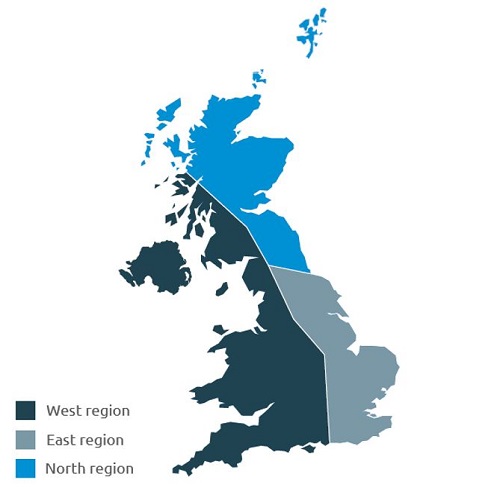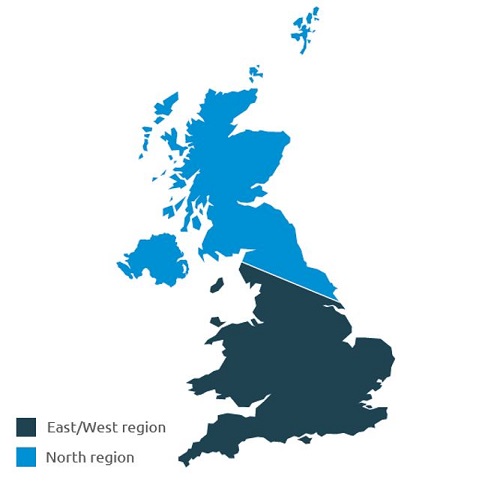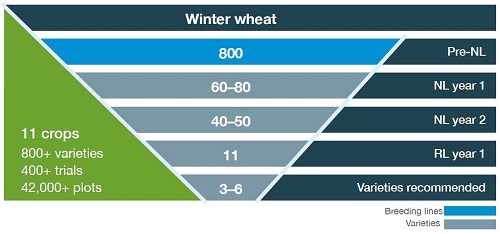- Home
- Knowledge library
- Using the Recommended Lists for cereals and oilseeds (RL)
Using the Recommended Lists for cereals and oilseeds (RL)
What are the types of list? What does ‘scope of recommendation’ mean? How are yields and disease ratings calculated? This page answers these questions (and more) to help you get the most out of the Recommended Lists (RL).
Type of list
 recommended badge.png) AHDB
AHDB
Recommended
Available for the major cereal and oilseed crops, recommended varieties are considered to have the potential to provide a consistent economic benefit to the UK cereals or oilseeds industry. Recommended varieties are based on data from many trials.
These lists cover the following 'major' crops:
- Winter wheat
- Spring wheat
- Winter barley
- Spring barley
- Winter oats
- Spring oats
- Winter oilseed rape
 described badge.png) AHDB
AHDB
Described
Available for the minor cereal and oilseed crops and some major cereal crop varieties (usually for niche markets), described varieties are used when recommendation is not appropriate but there is demand for data and seed is likely to be available. Trials are conducted with the same rigour as recommended trials but are fewer in number. As a result, care should be taken when interpreting differences between varieties on described lists.
A new described variety is added to the lists if the breeder enters it into the RL trial system. There are no yield or agronomic targets for described varieties.
They are removed when seed is no longer available or the breeder or UK contact withdraws the variety.
These lists cover the following 'minor' crops:
- Spring oilseed rape
- Spring linseed
- Winter triticale
- Winter rye
Described varieties for the major crops are displayed to the right of the main RL tables (in a straw colour).
 candidate badge.png) AHDB
AHDB
Candidate
Current candidate varieties are published, along with the UK contact, after each main table in the RL.
Varieties are usually in their first or second year of RL trials, having completed at least two years of GB and NI Variety Lists (VL) trials.
If data is sufficient, they are considered for recommendation in the autumn.
Once candidate varieties have been added to the VL, yield and agronomic data is published in the candidate lists on the AHDB website and on the RL app.
New recommended varieties
New varieties must show a positive ‘balance of features’ (compared with varieties on the lists) to be added to the trials and be recommended. This could include advantages in yield, pest or disease resistance, agronomic characteristics and quality characteristics (or a combination).
Yield is compared against the highest-yielding listed varieties.
‘Comparator’ varieties are used to assess pest, disease and quality traits – these are recommended varieties with strong agronomic and/or quality characteristics.
Characteristics are assigned different levels of importance. For example, septoria tritici disease resistance has a higher level of importance than mildew disease resistance. The characteristics and their importance are determined by the RL crop committees.
Find out about the RL board and committees
Reviewing and removing recommended varieties
Typically, recommended cereal varieties are removed from RL trials when their market share falls below 2% (based on certified seed production) and from the list the following year. However, varieties with low market share may remain on the list if they have an important market niche or are the sole representative of recommendation for a specific use.
Oilseed rape varieties have rapid turnover and are removed from trials and, subsequently, the list after two years, unless they are still very widely grown.
Any variety can be called for review by the crop committees, if an issue is identified. Any variety withdrawn by the breeder is removed immediately.
Varieties removed from the latest RL are detailed in the table footnotes (see ‘Varieties no longer listed’).
Criteria for recommendation and re-sowing
More than 2% above the yield target
Automatically recommended, if minimum standards and target specifications are met.
Between 0 and 2% above the yield target
Expected to recommend, unless there is a relative weakness in the balance of features.
Yield target
Between 0 and 2% below the yield target
Expected to not recommend, unless there is a positive balance of features.
More than 2% below the yield target
Expected to not recommend, unless there is an exceptionally positive balance of features.
Status in the lists
For each list, the first few rows feature information about the status of each variety.
End-use group
For wheat and barley varieties, the end-use group indicates potentially suitable markets.
The RL also features numerous measures of grain (cereals) and seed (oilseeds) quality.
Aways speak to merchants before committing to varieties.
Scope of recommendation
This may refer to a UK or regional recommendation, or a recommendation for a specific end use or agronomic feature.
Variety status
Variety status highlights new varieties added to the current RL.
It also indicates the current control (C) varieties.
Before a variety is taken off the RL (no longer recommended or withdrawn by a breeder), it is normally removed from trials. Where applicable, an asterisk (*) is added to the variety status line.
Varieties not added to the RL
The main AHDB RL web page also features information on varieties grown in trials but not added to the latest edition of the RL.
Clubroot-resistant oilseed rape varieties
Resistant to common clubroot strains, these varieties are recommended for growing on infected land. Some strains of clubroot may overcome the resistance in these varieties. Growing clubroot-resistant varieties repeatedly will select for these more virulent strains, potentially causing the resistance genes to become ineffective.
Yield calculations
Yields are calculated as a percentage of the controls. Established varieties are selected as controls and the average yield of these varieties is set to 100%. For example, if the average yield of the control varieties is 10.2 t/ha, a variety that yields 10.4 t/ha will be shown as having a yield of 102%.
Annual yields
Annual yields show how varieties performed over seasons. Consistent yields, over several years, may indicate that a variety offers a level of yield stability.
Oilseed rape yields
For oilseed rape, seed yield and gross output is presented. The latter is calculated from the seed yield with an adjustment to take account of the oil content.
Oilseed rape regional lists
Winter oilseed rape varieties are presented on a single UK list. Regional recommendations are also maintained, with varieties ordered according to the scope of recommendation. Varieties that are suitable for both the East/West and North regions have a UK recommendation.
Cereal regions
 AHDB
AHDB
Winter oilseed rape regions
 AHDB
AHDB
Notes
- Regional yields are calculated for winter wheat, winter barley, spring barley and winter oilseed rape
- Regional yields are based on fewer trials and should be treated more cautiously
- Divisions between regions are not absolute
- Growers are advised to consider which region is most appropriate for their conditions
- Results for spring wheat, spring oilseed rape, spring linseed, spring oats, winter oats, winter triticale and winter rye, are presented for a single UK region (because of the relatively low number of trials)
Agronomic traits
Disease resistance
Disease symptoms are assessed (for numerous diseases) in wheat, barley, oat and oilseed rape varieties.
The assessments involve a combination of natural infection and inoculated trials across the UK.
Information is only used where relatively high levels of disease are present. This helps prevent low disease pressure being mistaken for resistance.
In the RL, varietal disease resistance ratings are published on a 1–9 scale for several key diseases, where 1 indicates low resistance and 9 indicates high resistance.
- Varieties with ratings of 4 or less can be interpreted as susceptible
- Varieties with ratings of 8 or 9 can be said to have high resistance
Ratings cannot determine the durability of the resistance.
An introduction to disease resistance and ratings
Lodging in cereals
The RL provides a lodging resistance rating for each winter wheat and winter barley variety – with and without plant growth regulators (PGR). The RL also includes lodging ratings without PGR for spring barley, winter oats and spring oats. Finally, resistance to brackling is also presented for spring barley. Ratings use a 1–9 score, where 9 indicates a high level of resistance to lodging.
An introduction to lodging (including brackling) in cereals
Ripening in cereals
Ripening is expressed as days earlier or later than a standard variety. Varieties with a negative number are earlier to mature than the standard variety. The numbers are from RL trial data, but differences can be far greater on farm, particularly where growing conditions are more marginal.
Flowering and maturity in oilseeds
Flowering and maturity are scored on a 1–9 scale, where one is late and nine is early. Flowering is on a relative scale, with the earliest flowering variety scoring nine. Maturity is based on the degree of canopy senescence and is recorded just prior to swathing or desiccation.
Sprouting
Sprouting resistance is based on special irrigated test plots. A higher number represents better resistance to sprouting. Data is limited, so, in the absence of a score, the Hagberg Falling Number (HFN) may provide some guidance – a variety with a low HFN may be prone to sprouting.
Least signifcant difference (LSD)
Statistical significance
Natural variability, within and between trials, means that differences may occur due to chance, rather than an actual (repeatable) effect.
For most numerical characteristics in the tables, an average least significant difference (LSD) is reported.
Differences between variety means that are larger than the LSD are likely to reflect genuine differences, as they would only occur by chance fewer than 1 in 20 times (5%).
Differences smaller than the LSD are more likely to occur by chance and should be treated with caution.
Parentage
Information on varietal parentage (where known) is given on the RL app, variety selection tools and variety comments. Parentage gives an indication of the genetics that a variety could have inherited, but not what it has actually inherited.
Further information
RL timeline
Jul–Nov: Regular data from the RL trials published (Harvest Results)
Nov/Dec: Latest RL edition launched as online tables
Jan/Feb: Latest RL edition launched as a booklet (winter edition)
Jan/Feb: Latest RL edition used to update digital tools (e.g. app)
May: RL booklet edition revised (summer edition)
All year: Latest candidate data added to the online tables and app
The RL in numbers
More than £25 million invested*
£12,832,434 AHDB investment
£12,309,850 industry investment
 AHDB
AHDB
*Investment figures based on the 2016–2021 RL project. Crop and variety figures based on typical annual numbers. NL = National List.

